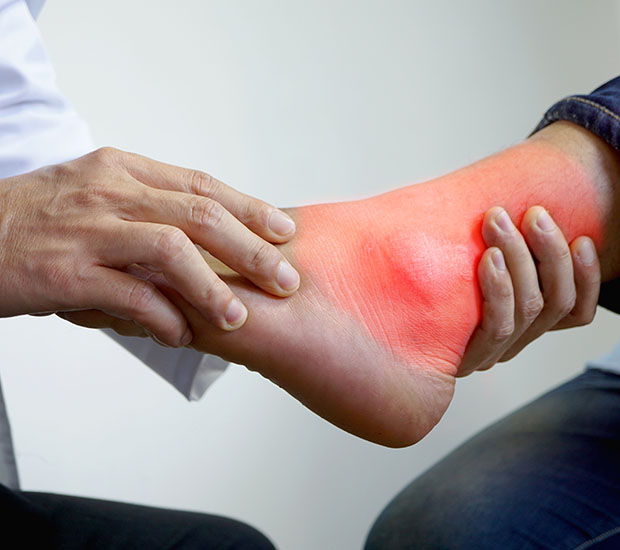Ankle Pain TreatmentNewport Beach, CA
While ankle pain can stem from a variety of different conditions, it can also result from accidents. Ankle pain due to injury is typically described as a strain or sprain. Whether the ankle pain is mild or severe, it is crucial to seek medical care to prevent further complications from arising. Understanding the causes and type of ankle pain allows you to seek the proper treatment and help significantly improve recovery.
At Orange County Physical Therapy, we offer ankle pain treatments for patients experiencing pain and other related symptoms. Our team can assess your condition and provide the proper treatment while going over the necessary steps to manage your pain at home. To learn more about a procedure or schedule an appointment, call (949) 299-0297 today.
Understanding Ankle Pain
Ankle pain refers to pain, discomfort, or other related symptoms in the ankle region. While minor ankle pain may improve with at-home remedies, such as resting, cold compresses, and pain relief medications, more severe ankle pain stemming from a condition often requires medical treatment. Physical therapy helps strengthen the muscles in the ankle to aid in healing, relieve pain, and prevent future injuries from occurring.
Ankle pain can be classified as a strain, sprain, or break. The difference between sprains and strains is in the part of the body affected by each injury type. A sprain involves the stretching or tearing of ligaments, which are tough bands that connect bones inside joints. A strain involves the stretching or tearing of a muscle or tendon, commonly known as a muscle strain. A break involves a broken bone in the ankle region. Strains and sprains vary in severity from mild to severe, while most breaks are considered severe and result in extreme pain.
Check out what others are saying about our Ankle Pain Treatment services on Yelp: Ankle Pain Treatment Newport Beach
Common Causes of Ankle Pain
Ankle sprains are so common that anyone runs the risk of this type of injury every day. Simply stepping on uneven ground can twist and sprain the ankle. When the ankle suddenly loses stability while stepping down, the potential for extensive damage rises greatly. If it happens badly enough, a person could break an ankle bone or suffer a fracture. Such injuries add to the pain and increase the need for physical therapy to help hasten the healing process.
The most common causes of ankle pain are injuries, diseases, disorders, and health conditions including:
- Arthritis: Arthritis is a condition that occurs when the joint tissues, or cartilage, break down. Worn down cartilage causes bones to rub together and results in pain.
- Bursitis: Occurs when the bursae sacs that cushion the bones in the ankle become irritated and inflamed.
- Flatfoot: Feet that have a small arch or no arch at all cause ankle pain due to the lack of support of the hell and forefoot.
- Fractures: Occurs when any bone in the ankle joint breaks, causing swelling and pain.
- Gout: A condition that results in the buildup of uric acid throughout the body and creates crystals that settle in the joints, causing pain.
- Infection: A variety of infections can lead to swelling and pain in the ankle joints, such as staph infections and cellulitis.
- Sprains: Occurs when ligaments are stretched or torn due to the ankle rolling forcefully out of position.
- Tendonitis: Occurs when the tendons, which connect the muscles to bones, become infected, inflamed, or, in severe cases, torn.
Signs and Symptoms of an Ankle Injury
As uncomfortable as it is, pain is an effective indicator of the type of symptoms, and condition the patient is struggling with. These symptoms and signs provide us with essential information in developing a diagnosis. However, most causes of ankle pain (and pain in other parts of the body) present the same symptoms. It is important that patients watch for other symptoms accompanying pain and recognize any changes in their condition.
Signs of an ankle injury, such as a sprained ankle, may include any or all of the following:
- Pain, often sudden and severe
- Swelling
- Bruising
- Inability to walk or bear weight on the injured joint
Patients experiencing any of these symptoms or unusual symptoms following a session should communicate with their physical therapist as soon as possible. It is normal to have some pain and discomfort, especially after the first few sessions. However, we need to document any changes in the patient’s condition and may alter their sessions as needed.
Treatments for Ankle Pain
Physical therapy has many benefits that can help reduce ankle pain while boosting the healing process without the use of addictive opioids and pain medications. Treatment will depend on the cause and type of ankle pain the patient is experiencing. We will examine the affected area to identify the injured muscle or ligament while also documenting symptoms and pain levels. After finalizing the diagnosis or assessing the primary physician’s diagnosis, we will curate a personal treatment plan for the patient.
Treatments for ankle pain include using cold compresses, exercising the affected area, taping the arch of the foot or the affected leg muscles, massaging the injured tissue using the hands, and performing various stretching exercises. Physical therapy treatments can help reduce pain and swelling, improve flexibility, motion, and strength, enhance endurance and balance, restore agility, and speed up recovery time. We will discuss each individual’s treatments and recovery time during their initial consultation.
Post-Treatment and Recovery
Following each session, we recommend patients rest and put as little pressure as possible on their feet. Physical therapy eases pain and heals the ankle and foot over time, but it does require activity, which can cause discomfort after the sessions. It is important to give the feet a break to avoid straining them and allow them to heal prior to the next session.
Recovery time for ankle pain varies depending on severity. Mild pain, such as from a sprain or strain, generally resolves within three to five weeks; moderate pain, such as a twisted ankle, can take from four to six weeks; severe pain, such as with a fracture or break, can take anywhere from three to six months. During that time, we will provide the patient with post-treatment care instructions and prescribe any pain medications as we see fit.
Schedule a Visit Today
Ankle pain consultations and treatments are available at our office. The Orange County Physical Therapy team looks forward to treating you and helping you get back on your feet as soon as possible. Call our office at (949) 299-0297 to learn more or schedule an appointment.
Frequently Asked Questions About Ankle Pain Treatment
Q. What does ankle pain indicate?
A. Ankle pain can be an indication of a variety of conditions or injuries. Pain can result from a sprained or strained ankle, a fracture, or a torn ligament. Some patients experience ankle pain from improper sitting or standing up too quickly. Pain that resolves on its own will likely not require physical therapy unless it persists for longer than normal.
Q. How do I speed up the recovery process?
A. An effective way to speed up the recovery process is to implement the R.I.C.E. method one to three times daily, which involves resting, icing, compressing, and elevating the affected area. Additionally, it is important to seek medical assistance as soon after the injury as possible for proper diagnosis in treatment, especially when attempting to make a fast recovery. Most importantly, resist the urge to return to what caused the injury (e.g., sports, running, etc.) until a full recovery is made.
Q. How can I prevent spraining or injuring my ankle?
A. There are several steps you can take to prevent a sprain or strain from occurring, although the risk is always there during physical activity. To give yourself the best chance possible to prevent a sprain or strain, be sure to conduct a warm-up activity before going through a thorough stretching routine. There are also braces (for joints) or compression sleeves (for muscles) for particular areas to provide more stability and safety of that area. Keep in mind it is important to warm up the body before stretching.
Q. How can I still stay active while recovering from an ankle injury?
A. The only way to truly recover from a sprain or a strain is to rest and properly apply the treatment necessary. It is important to be patient with a sprain or strain, as there is a high chance of re-injury if it is not properly rested. With that said, you may be able to alter the way you practice, especially while playing sports. If you endure an ankle sprain while playing basketball, perhaps find an area of practice that does not involve any use of the affected area, such as shooting baskets in a chair.
Q. What are the most common causes of an ankle sprain?
A. A blow to the body that causes the ankle to twist and turn can lead to an ankle sprain. For strains, the most common cause is overuse, which leads to a chronic strain. An acute strain happens suddenly, and it is most often caused by a blow to the body or overstretching, which is common in weightlifting, sprinting, and sports activities.
Contact Us
Orange County Physical Therapy OCPT is located at 2135 Westcliff Dr. Suite 203 Newport Beach, CA 92660.





